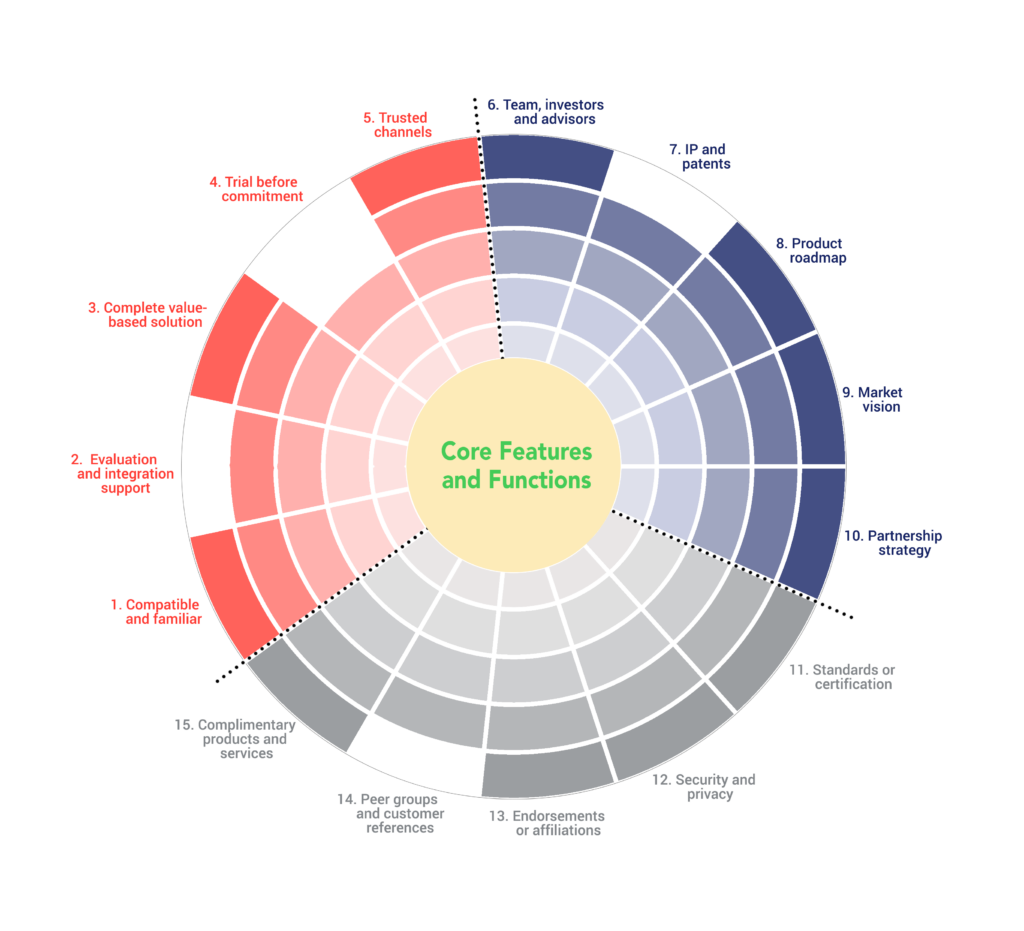All Successful Innovations Have
Three Elements in Common

1.
End User Harmony
Seeing the world from the customer’s point of view, and creating a product that fits them so well, that it sells itself.
2.
Reliability and Commitment
Using your category and domain expertise to perform consistently well, and demonstrate the characteristics of an ideal partner.
3.
Safety in Numbers
An independent infrastructure that allows people to interact with others they relate to, find independent sources of support and feel safe.
These 3 Elements Lower the Perception of Risk
Many great innovations, social movements and new technologies take decades to achieve mainstream or mass-market adoption, primarily because of a failure to lower the perception of risk. And the underlying reason for the lack of innovation adoption is a vast majority of people don’t want the latest and greatest…of anything. The mainstream population primarily wants low risk, evolutionary progress and familiarity.
Here are five examples of innovations that evolved over time to lower the perception of risk. All of these innovations achieved widespread adoption in the mainstream because of they have a common set of risk-lowering attributes that allow people to feel safe:
- The electric lightbulb
- Vermont’s COVID vaccination program
- Digital photography
- Regional solar power
- The personal computer

| 1. End User Harmony |
|
| 2. Reliability |
|
| 3. Safety in Numbers |
|
The Electric Lightbulb
One of the best examples of the low risk recipe is Thomas Edison’s strategy of adapting his invention to systems people were familiar with, and minimizing disruption to people’s lives. Together this led to accelerated acceptance and adoption of the electric lightbulb.
Since gas lamps were the dominant method of indoor lighting, Edison designed his electric lights to look and operate almost identically. His initial electric lights provided 13 watts of light, almost the same as the 12-watt gas lamps he wanted to replace.
Recognizing that many commercial and residential landowners in New York had invested considerable capital in gas infrastructure to light their buildings, Edison chose to run his first electrical wires through existing gas lines, fitting directly into the system people already understood for the delivery of light.
Edison also understood that the light bulb was merely a discrete device. And a system of electric power generation and transmission would be required to make it truly useful. Edison’s Pearl Street Station provided a complete electric lighting, generation and distribution system that ensured the safe, reliable delivery of electricity at competitive prices.
In order to ensure Safety in Numbers, Edison selected financial institutions in lower Manhattan to demonstrate electric lighting technology to the metro population living across the Hudson River in New Jersey. Because financial organizations were seen as a credible source of innovative new products, these “visual references” acted as an endorsement of electric power and light.
Vermont's COVID
Vaccination Program
The adoption of a healthcare innovation — such as a vaccine to prevent the spread of COVID — requires people to make medical decisions based on individual risk-benefit analysis. In this example you can see that the State of Vermont took specific steps to lower the perception of risk through the creation of a program called “Keeping You Safe.”

Vermont Health Commissioner Dr. Mark Levine was quoted by the Associated Press as saying “the nation has witnessed what is probably the most successful population-wide mass vaccination campaign in the nation’s history.” And Vermont’s historic success is the result of designing a vaccination program that lowered the perception of risk for all residents.
Vermont’s vaccine program incorporated many of the risk-reduction methods that are important to a mainstream population: it was sponsored by an unbiased organization that is dedicated to clear communication (NPR), all vaccines were administered in familiar locations and settings, the alternative vaccines that were offered have the same underlying biological structure, and the use of town hall meetings and community-centered gatherings allowed citizens to discuss their concerns with people they relate to and trust.
The Most Successful COVID Vaccination
Program in the World
1. End User Harmony
- Vaccinators were culturally competent (in 10 different languages) and appropriate for the setting
- Excellent compatibility; no mass vaccination sites; vaccine delivered to people at: general stores, gas stations, car races and local events
- Value alignment based on personal safety
- One-stop source for vaccination information and consistent guidance (state health agency)
- Visible references at town hall meetings
- Communication through trusted channels such as: first responders, immigrant aid groups and respected local pharmacists
2. Reliability and Commitment
- Managed by the Vermont Agency of Human Services
- Brand awareness built through 145 briefings regarding strategy, plans and status
- Market vision called “Keeping You Safe”
- Partnerships with rural emergency medicine organizations
3. Safety in Numbers
- Standard vaccine provided (Messenger RNA)
- HIPPA regulations provided security and privacy
- Vaccination program sponsored by Vermont Radio (NPR)
- Complimentary products included additional healthcare services
- Early adopters presented their experience to late adopters at community meetings
- Town hall meetings organized by NPR enabled peer-to-peer interaction

| 1. End User Harmony |
|
| 2. Reliability |
|
| 3. Safety in Numbers |
|
Digital Photography
Sony was able to lower the perception of risk primarily by taking advantage of digital photography’s lack of standards.
Despite being more expensive, clunkier, and less capable (it didn’t produce the sharpest pictures) the Sony Mavica was the top-selling digital camera in the U.S. While competitors like Casio were all concentrating on technical performance like picture resolution, Sony focused on avoiding features that force a customer to change. Instead they emphasized familiarity, allowing mainstream buyers to feel safe.
Manufacturers of digital cameras like Cannon, Fuji and Casio thought buyers would want advanced features like better resolution and more storage. But Sony took advantage of the industry’s lack of standards (which are a proven way to lower the perception of risk) and designed the Mavica to work with a standard storage device, the floppy disk. They also made the Mavica extremely easy to use. The result? Despite higher price and less functionality, the Sony Mavica was the market leader in its category with 41% market share.
Regional Solar Power
The challenge with clean-energy market transformation is getting people who are primarily risk averse to adopt a new innovation. The mainstream population believes that most new technologies are unproven and risky. However in this example, a properly designed risk-reduction strategy overcame adopter hesitancy and accelerated the acceptance of solar power in Sacramento County, California.
Sacramento residents signed up in droves for the privilege of putting 4 kW grid-connected solar panels on their roofs, despite the cost of well over $10 per watt. (today the cost is about $2 per watt) The program, sponsored and administered by the Sacramento Municipal Utility District (SMUD), was sold out from the very beginning due to the perception of low risk, which attracted both early- and late-majority members of the mainstream.

SMUD’s PV Pioneer Program offered a complete solar solution, that was sold and installed by trusted suppliers, which made the buying experience familiar and low risk.
To accelerate mainstream market acceptance, the utility: standardized the system, subsidized local manufacturing of solar panels to ensure high quality, invested heavily in community outreach and education, integrated the rooftop solar systems with the existing electrical grid, and trained and certified local solar companies.
The impact of a utility or familiar vendor offering a low-risk product makes all the difference. All of the requirements of a risk-averse, mainstream buyer were satisfied.
| 1. End User Harmony |
|
| 2. Reliability |
|
| 3. Safety in Numbers |
|

| 1. End User Harmony |
|
| 2. Reliability |
|
| 3. Safety in Numbers |
|
The Personal Computer
Mostly through coincidence and accidental synergy, IBM created an ultra-low-risk product that launched a massive transformation, and the personal computer became a mainstream appliance. Intangible attributes in all three sections of the Low Risk Recipe allowed PC adoption to soar.
When IBM sponsored development of the “IBM compatible PC” along with its clone architecture, the foundation for safety and predictability in personal computing was established.
End-user harmony was provided through the availability and delivery of complete solutions including an operating system, hardware, peripherals, application software and extensive documentation. Familiar retail stores such as Sears allowed prospective customers to test drive and explore PCs before purchase. Along with Sears, computer-specialty stores such as Computerland and Computer City were chosen to introduce the IBM PC.
Even with a complete product offering and familiar distribution channels, the cooperation between vendors in the PC category was even more transformative. Because the IBM PC was built from commercially available, off-the-shelf parts, all other PC vendors had full and open access to IBM’s design. So, the entire industry organized itself around the IBM-compatible hardware standard. IBM PC “clones” included a standardized ATX/AT form factor, a basic input-output system (BIOS) and an ISA/EISA bus standard. When PC manufacturers adopted this standardized configuration, it eliminated the potential risk of “vendor lock-in,” and full-scale mainstream adoption followed. A virtually unlimited supply of how-to books and manuals were available to support application software such as Wordstar, Lotus 1-2-3 and Ashton Tate DBASE .
One of the risk-lowering mechanisms included in the PC clone standard was the implied compatibility with the world of computing, which was made possible by IBM’s participation and sponsorship. The availability of a standardized product, and hundreds of complimentary add-ons along with the sponsorship of the most dominant name in computing allowed PC adoption to skyrocket.
Last but not least, attributes providing Safety in Numbers included the availability of independently-produced anti-virus software, as well as independent service providers and consultants. But the greatest impact came from the plethora of user groups that self-organized to provide an independent source of information and support for users of all kinds.

